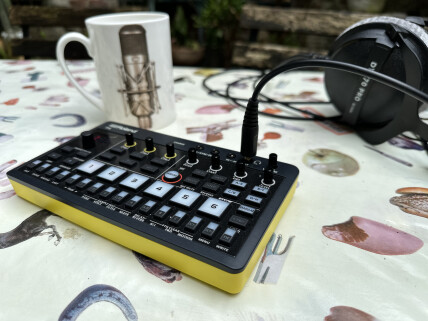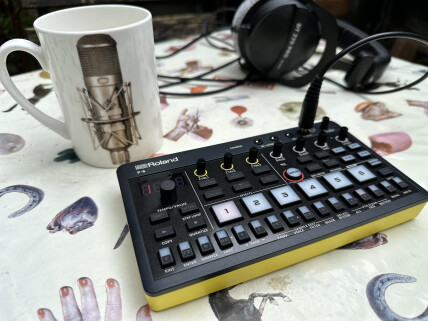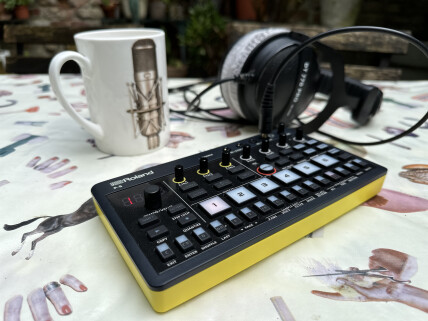A sampler, granular engine, sequencer, effects and lots of fun in a small, pocket-sized box: that's Roland's promise for the latest addition to the AIRA Compact family. Can it claim a choice place among your creative tools?

Ten years ago, Roland introduced the AIRA family, a series of instruments designed primarily for the stage and strongly oriented towards dance and urban music. Eight years later, in 2022, the AIRA Compact series was unveiled. Still strongly oriented towards modern music, it’s a set of ultra-portable tools for musicians seeking mobility and creative solutions.
The fifth and smallest addition to the family, the AIRA Compact P-6, aims to carve out a place for itself in the rapidly expanding market for compact samplers. In recent years, releases by Teenage Engineering, Sonicware, Novation, and Korg (…) attest to the renewed interest in these little boxes, which focus above all on creative features, live play and simplicity. They are often, as here, associated with a sequencer and effects, to which the P-6 has the good idea of adding granular synthesis.
Aira Tower
The AIRA P-6 has an identical physiognomy to the other family members, this time with a yellow underside. Measuring 188 × 106 × 37 mm (7.4 × 4.2 × 1.5 inches), and weighing 305 g (10.7 oz), it’s even more frail than a Korg Volca Sample, which, at 193 × 115 × 45 mm (7.6 × 4.2 × 1.5 inches) and 372 g (13.1 oz) looks almost chubby by comparison. Its size means it’s perfectly at home on bucolic or urban strolls, where you’ll be pulling it out of your pocket, in which it’s been waiting for a surge of inspiration.
.
The top facade is divided into six sections. On the top of the device is a charge indicator, part of the connectivity, with sync input and output, an audio input and a stereo output/headphone jack. By connecting a headset to the latter, it also functions as a microphone input. All connections are in minijack format. This section is completed by the output volume knob.
On the left-hand side are the general controls, with a four-character, seven-segment LED display and a value encoder. These are followed by four pushbuttons: a much-used Shift button, a Pattern button and the transport controls. Like almost all P-6 controls, they can have different functions.
We continue this quick tour with the effects section. Consisting of three “Control” rotary controls and six switches to activate in turn a looper, pitch effect, delay, filter with distortion, scatter effect and multieffect. On the right-hand side are the controls for managing samples, as well as a small built-in microphone (more on this later). Then there are four buttons for managing the sample bank, another for granular synthesis and six pads. While the latter are pleasantly textured, they are unfortunately not velocity-sensitive. What a pity.
Finally, on the lower part are sixteen small buttons, backlit like all those on the device. While primarily dedicated to the step sequencer, they also activate secondary functions (with the help of the Shift or Pattern buttons) and serve as a mini-keyboard.
The rear panel features a power switch, a USB-C port, and two MIDI sockets (In and Out). Again, these are in minijack format, and an adapter (not supplied) is required to connect the unit to an external MIDI device. Incidentally, the P-6 is designed to connect to other members of the AIRA Compact family: in addition to the usual synchronization options, it’s possible to control part of the granular synthesis with the AIRA S-1.
Completely plastic, the workmanship is decent. The eight small knobs are well anchored, even if they show a very slight play, which is nothing abnormal in this price range. It’s hard to say how they’ll hold up over time, but the whole thing is engaging and presents well.
Let’s finish with the contents of the box. It contains the instrument, a USB-C to USB-A cable, a “Read me first” leaflet, and that’s it. The absence of a power supply is still surprising, although it’s become a more common occurance. The fairly complete but laconic user manual can be viewed or downloaded from the Roland website in HTML or PDF format. Roland also offers an optional carrying case and various MIDI cables.
Power is supplied by a lithium-ion battery, that Roland says will last about three hours in continuous use. In our various tests, it never fell below this time.
Playing area
About six seconds after switching on, the P-6 is ready to make music. The level is correct, and the 48 slots of the sample bank are already filled with short, high-quality samples and loops. Of the 64 patterns available, the first 16 are demo sequences. While all this gives a good overview of the P-6's capabilities, it is, of course possible to overwrite them if you want. In the meantime, it makes for a more than welcome starter set before getting down to business.
While the basic operations are obvious, it soon becomes clear that you will have to familiarize yourself with the logic of the instrument, which relies heavily on key combinations. The information displayed on the small screen isn’t always helpful, as you often have to refer to the operating instructions to understand the many abbreviations. Fortunately, we’re helped by the luminous indications of the various push-buttons. On this subject, the illumination of these in daylight proves insufficient for perfect visibility. This is somewhat understandable but regrettable for an instrument whose main selling point is outdoor play. Incidentally, the absence of a small loudspeaker is also regrettable, whereas it is present on many of its competitors. It should also be noted that, depending on the position of the instrument, the position of the Tempo/Value encoder can prove awkward: fingers quickly hide the display and its precious information. It has to be said, though, that cramming so many usable functions into such a small surface area is quite a feat and deserves to be highlighted.

- 01 – Particules – tweak SFX and granular00:59
- 02 – Dark steps00:57
- 03 – Autumn in Amsterdam – Tweak SFX and Granular00:43
- 04 – En vrille – test scatter et looper00:36
- Demo 1 – Grainy Bells00:42
- Demo 2 – Old Memories00:53
- Demo 3 – Jungle Search – Demo SFX00:13
- Demo 4 – Granular Seas00:37
- Demo 5 – Get Busy01:35
- Demo 6 – Autumn in Amsterdam00:42
- Demo 7 – Voice Of The Mountain00:49
- Demo 8 – Grain Of Lights00:55
In addition to charging, the USB-C port has other uses. For example, it enables communication with a computer as MIDI input and output, so the P-6 can act as a MIDI controller. But also, and more importantly, audio transits through this port, enabling the instrument to be used as an auxiliary audio interface, for example on a smartphone. Bravo!
Samples are exchanged with the computer using the P-6 SampleTool application, available for macOS and Windows. To download it, you need to create an account on the Roland website and then go through Roland Cloud Manager. From here, samples can be easily edited, and clicks removed, for example. This is facilitated by the Snap To Zero function. It’s also possible to reduce the resolution of samples, which is useful for saving space. Sending samples (WAV format) to the P-6 is done by drag-and-drop on the latter’s front panel, graphically represented in the software.
Air to sample
Let’s move on to the P-6's main raison d’être, sampling. The source can be the built-in microphone, USB audio, the Out jack if a headset is inserted, and audio input. For the latter, it’s possible to connect all kinds of peripherals, mono or stereo (with adapter), from synthesizers to turntables and, of course, dynamic microphones. Samples are managed via six pads, each with eight slots, named A to H. To sample, first select a pad with a free slot. If none is available, you’ll need to delete a sample. This is very easy: first, press the Delete button, select the location, and then press Delete again. Once this has been done, press the Sampling button to start recording.
Unfortunately, the internal memory is modest in size, but Roland offers a choice of four sampling frequencies. By choosing a lower resolution, you can save a little space. You can sample at 44.1 kHz, 22.05 kHz, 14.7 kHz and, for a really crunchy sound, 11.025 kHz. Using the highest rate of 44.1 kHz, the sampling time is just 5.9 seconds in mono. At 11.025 kHz, the highest sampling time is 23.7 seconds in mono. These times are halved for stereo sampling. You can set a level at which recording starts and trigger it via MIDI. Handy tip: the illumination of the bottom row of buttons acts as a vu-meter.
Once a sample has been saved, it can be customized. You can, of course, adjust the pitch, modify the start and end points, and adjust the volume and panning of each sample. A gate/one-shot mode is also included. Several playback modes are available besides normal: reverse, loop and alternate loop. The P-6 features an interesting chop function. This divides a sample into 64 segments, which can be organized using the step sequencer keys. It’s a fun way to deconstruct a loop. You can also copy and exchange samples between pads.
Another interesting function is step sampling, which allows you to segment the recording and thus have perfectly cut samples.
The built-in microphone gives the P-6 excellent mobility. Thanks to this, it’s easy to capture voices, street noises, domestic sounds, nature sounds and more. Field recording enthusiasts will have a “field” day. The recording quality through this mic is honest and in keeping with the instrument’s philosophy.
One of the bike’s great strengths is its granular synthesis engine. Simple to use, it opens the door to highly experimental and creative sonic explorations that could attract an audience not initially targeted by Roland. It is operated via the Granular button, which acts as a sort of seventh pad. All samples recorded in the P-6 can be processed here. There’s a lot of fun to be had with this function, and its relative simplicity makes it both accessible and fun to use.
To conclude this chapter, let’s also mention the ability to resample the output with effects and the possibility of playing samples in monophonic or polyphonic mode, up to 16 voices, while granular synthesis is limited to four voices.
This entire section is undoubtedly the instrument’s principal asset, even with the absence of time-stretch, especially with such a limited memory.
Era synthesis
In addition to its functions relating to sample manipulation, the AIRA P-6 contains a small synthesis section. While the seven little knobs are used for editing, here, you still have to make key combinations with the help of the Shift key. Each sample has its own pitch envelope, with a choice of ADSR, ADR or cyclic. There’s a LoFi module and multimode low-pass, band-pass, high-pass and peak filters. The latter amplifies a narrow band around a chosen frequency. The color of this digital filter is pleasant, with a resonance that flirts with self-oscillation. It can be modulated with an envelope. While this envelope also offers a choice between ADSR, ADR and cyclic, it is unfortunately common to the volume. Finally, the PAN section, in addition to its basic function, can be configured as an auto-pan.
If we hoped to find the equivalent of a research synthesizer in the P-6, the presence of an LFO would have been welcome: the envelope can operate in cyclic mode, but as it’s shared between the volume and the filter.
Steps in time
To bring all this to life, the P-6 features a 64-step sequencer with a 64-pattern memory. Each of the 48 samples has its own sequence line, the limit being 16-voice polyphony. Recording can be carried out in step-by-step or realtime mode, with the pads or bottom keys configured as a keyboard. You can also use one of the quantization settings and the metronome. The metronome features a configurable countdown, a rather rare option in this category, yet a very useful one. There’s no tap tempo, though.
Pattern editing can be done by programming elements such as note length, velocity, gate, off-grid, microtiming and even probability. To keep sequences moving, you can also record parameter movements. For live performance, the Step Loop function lets you loop part of the current sequence. This makes it easy to create transitions and rolling effects.
Unfortunately, this section, though nice, is heavily penalized by the absence of song mode or pattern chaining.
Here, too, the key combinations and limited screen display are limitations for spontaneous use.
Aira effects
A few words about the effects section, which takes up a good part of the P-6's front panel. A total of 20 effects are available, five of which can be accessed directly: DJFX Looper, Chromatic Pitch-shift, Sync Delay, Filter + Drive and Scatter. The others can be accessed via the MFX button and include a reverb with four types (two halls, one room and one ambience), a compressor, the classic chorus, flanger, phaser and tremolo, as well as a ring mod, an isolator, etc.
A word about the Scatter effect, which slices up the sound and modifies the length and playback direction of each fragment according to a pattern defined by ten algorithms. The results are sometimes surprising. Combined with granular synthesis, it’s possible to create all kinds of textures, from the most atmospheric drones to the craziest things. This section is essentially used as a performance module, in fact it’s possible to configure effects to activate only when their activation button remains pressed.
In addition, it’s also possible to set each sample to be sent to two general effects: a reverb and a delay. The reverb includes the Ambiance, Room, Hall 1 and 2, Plate, and Modulate algorithms. All these effects come from the big brother SP-404 MkII and are, on the whole, of good quality and quite usable. Nevertheless, the Distortion Filter is less convincing than the one in the Voice section. The resonance is a little aggressive, and the distortion setting lacks progressiveness. But perhaps that’s a matter of taste?
Finally, let’s mention the presence of a minimalist Mix section that only involves choosing between 3 buses.
You can view the full datasheet on the Audiofanzine product page.




















